Of all the queer erasure that has happened in history, probably the most egregious example was the simple coining of a phrase in the 18th century, by King Frederick of Prussia, a man. That phrase was: “dog is man’s best friend.” King Frederick was wrong: dog is lesbian’s best friend.
So let’s take a stab at rectifying the mistakes of the past by examining the many ways gay, bisexual, queer and other unquantifiably not-straight women have built lasting, meaningful and downright obsessive relationships with their canine friends over the years.
If you’ve been waiting your whole life to find people in history that really reflect who you are, today is that day!
Eleanor Butler and Sarah Ponsonby, aka The Ladies of Llangollen
Famed runaways Eleanor and Sarah were both daughters of wealthy minor nobility, whose families lived close to each other in 18th century County Kilkenny. Ireland. They met in 1768, and struck up a close friendship based on common interests such as literature, philosophy and rejecting patriarchal notions of marriage. So aghast were they at the prospect of marriage that they hatched an elaborate plot to ditch the trappings of heteronormative life.
One night in 1778, Eleanor rode the twelve miles to Ponsonbys’ home, to meet Sarah as she leapt from the window of the family castle, dressed as a man and carrying the essential elements for any escape plan: a pistol, and a small dog. The dog in question was Frisk, Sarah’s lapdog, and it was potentially Frisk’s yapping that would undo their attempt to flee, as they were caught in a barn while waiting for a ferry to take them to freedom. They were caught and marched home to stew on their failure, and then try again several times.
Eventually, their families relented and released them to sail over the Irish Sea to Wales , where they set up their life together in a gothic house called Plas Newydd (New Mansion) overlooking the town of Llangollen.
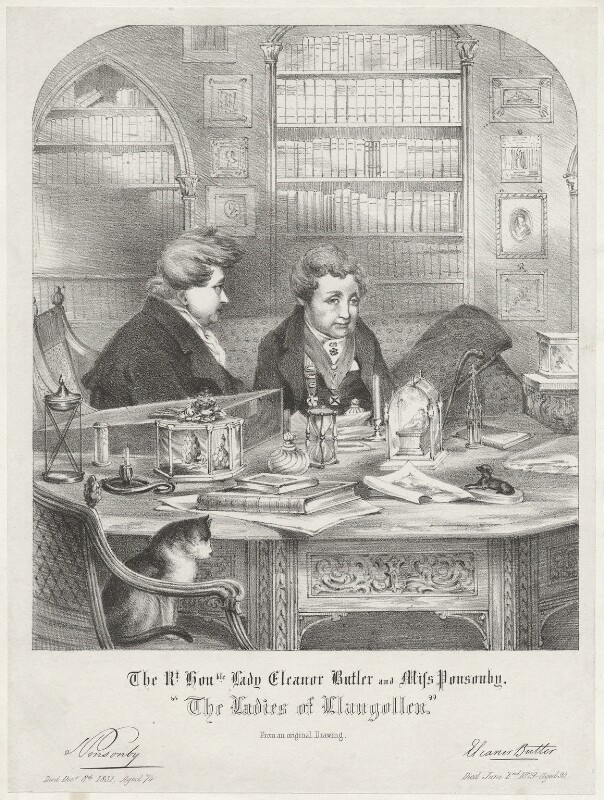
Eleanor kept a detailed diary throughout her fifty years with Sarah in Plas Newydd, and the pages make frequent mention of their numerous dogs: Flirt, Rover, Bess, Gypsey and Sapho (yes, that Sappho, which was commonly spelled this way in the 18th century). So while their devotion to their pooches is not doubted, there has been a lot more speculation about the exact nature of their relationship to each other.
People who are sure they’re not lesbians include chief LoLl scholar and biographer Eleanor Mavor, the really adamant narrator on the Plas Newydd audioguide, and the ladies themselves, who tended to act all shocked, and even threatened to sue a newspaper for libel when they implied it. People who were sure they were lesbians include literally everyone else that was alive at the time and who were obsessed with their romantic escape, such as lesbian-of-note Anne Lister, the poets Byron, Shelley and Wordsworth, who all visited the Ladies in their Welsh home.
I think you should make your own minds up about this, so let’s recap the evidence :
- Leapt out of window to escape the patriarchy
- dressed in men’s clothes
- HOLDING A DOG.
- Proceeded to live together for 50 years
- during which they constantly referred to each other as “my beloved,” “sweet love” and “better half”
- Named a dog after Sappho (also named a cat Muff)
If you are not yet convinced, check out this casual diary entry from Eleanor on May 11th 1789: “My beloved and I then walked on the Velvet Carpet of the Mountain…”
I think we’re done here.
Frances Power Cobbe
Born in 1822 to a wealthy family north of Dublin, Frances Power Cobbe formed and voiced strong opinions from an early age, frequently arguing with her father about religion and ethics. Her first book on that topic, The Theory of Intuitive Morals, was published anonymously lest she bring the family name into disrepute. Her father died when she was 35, leaving Frances a small pension and, finally released from familial obligations to be a dutiful daughter, she immediately took herself off around the world.

It was in Italy that she found a group of women living the independent, cultured and extremely gay lives she’d always dreamed of, spearheaded by notorious Sapphic actress and party girl Charlotte Cushman, also including artist Rosa Bonheur and the Welsh sculptor Mary Lloyd. In her own words she had found “young women in Florence and Rome thus admirably working their way; some as writers, some as artists of one kind or another, bright, happy, free and respected by all.” About the only thing she did not like about this idyllic situation were Cushman and her American friends’ prediction for waffles, which she called “an awful refection menacing sudden death.”
In Rome, Frances honed her skills as a journalistic writer, supplementing her paltry inherited income while exploring the political ideas she felt so passionately about. Two issues in her lifetime would rise to take precedence over others: women’s suffrage, with which she was actively engaged in the 1860s, and animal rights. Frances was staunchly anti-vivisection, and lobbied successfully for parliamentary rulings on the matter, as well as using her influence as a writer to shape public opinion. It can’t be underestimated the courage and conviction this must have taken, to fight against a male-dominated medical establishment whose arguments against her were based as much on misogyny as any principles they might have — one man described her as “a disenchanting mountain of flesh” because of her refusal to wear a corset, and John Ruskin, aghast that she should want to express herself so vociferously, deemed her a “cluttering saucepan.”
By 1958, Frances was in London, living with Mary Lloyd in a partnership that would last the rest of their lives. Although her purview of animal welfare was broad, Frances took a particular interest in dogs, authoring works contemplating their ability to think and feel such as The Consciousness of Dogs and Dogs Whom I have Met, as well as exchanging correspondence with Charles Darwin on the subject.
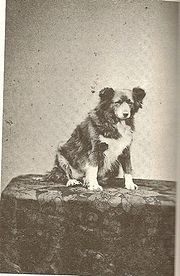
Frances riffed on the idea in her very fun novella Confessions of a Lost Dog; Reported by Her Mistress, freely available to read here. Published in 1867 to thank donors to the Battersea Dogs Home and advertise its good work, Confessions follows the life of Frances’s pet Pomeranian Hajjin (meaning pilgrim) from her own dog’s-eye view. The book covers essential topics such as birthing puppies, getting lost in the big city, and how not to cope when your mistress ghosts you for her queer pals (Frances visited Italy six times in total, and vividly imagines Hajjin’s distress on such occasions).
I could discern clearly, even at that early age, the essential difference between people who are kind to dogs and people who really love them. – Hajjin, from Confessions of a Lost Dog
Of particular interest are the times Hajjin mentions her mistress’s female “friends” and the judgements she makes on them according to their attitudes towards dogs. She describes one such unnamed friend, who must be Mary Lloyd, as so: “My mistress had her friend, a lady with whom she lived, and of whom I was a little jealous — a person very devoted to dogs, but with sterner views of discipline than I quite approved.” In doing so, she has perhaps described for the first time in literature the truth of lesbian domesticity.
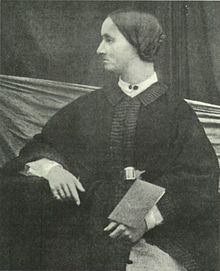
Katherine Bradley and Edith Cooper – aka Michael Field
Poets, playwrights and intimate collaborators both in literature and the bedroom, Katherine Bradley and Edith Cooper were also aunt and niece. Edith was born in 1862, when Katherine was 16, daughter of her elder sister Lissie, and from the get-go they formed an intense bond. When Edith was around 14 and frequently bed-bound with illness, Katherine would send her passionate letters from Bristol, where she was studying literature. By the time Edith was 16, the pair were devoted to each other; Edith went off to study with Katherine, and they proceeded to live together for the next forty years.
Love-delight has frolicked & throbbed unencumbered & ceaselessly.” Katherine Bradley, describing her relationship with Edith Cooper.
As part of a non-conformist family, rich from tobacco factories in the West Midlands of England, Katherine and Edith had been able to pursue more education than typical for Victorian women, and had written poetry from an early age. After little success publishing individually under pseudonyms, they began to collaborate on lyric verse and drama together, deriving the name “Michael Field” from the nicknames they had for each other. By their own reckoning, working together meant “we are even closer married” than lawfully wedded poets Robert and Elizabeth Barrett-Browning. Importantly, a man’s name would elicit a level of serious consideration that would never be afforded women: “we have many things to say that the world will not tolerate from women’s lips.” Their first work published under the name was a verse-drama called Callirrhoë, adored by critics who hailed Michael Field as the next Shakespeare. When Robert Browning inadvertently outed them as women, their subsequent work tanked, getting either bad reviews or none at all.

Nevertheless, the pair continued to write and live independent lives infused with a good deal of the drama they captured in their plays. This was most apparent in their relationships with dogs; an early episode saw Katherine renounce her Christianity for atheism in 1877, because the world was full of evil and the only good thing was her Skye Terrier. In 1897, Edith’s father went missing while climbing in the Alps, and was eventually found dead. To assuage their grief, the pair were gifted two dogs: the first, a Bassett hound from Edith’s sister Amy that they called Musico, and in January 1898, a Chinese chow puppy from friends in Bristol, who they named Whym Chow, after alpine climber Edward Whymper, who had helped look for Edith’s dad.
The pair were smitten with Whym and immediately began writing poetry praising his “full-furred loveliness“ and “coat of high strand like mountain juniper.” The Michaels elevated Whym above not only Musico, but above pretty much any other living being outside their own marriage. They moved to Richmond in London and plastered the walls with photos of Whym, filled their correspondence with tales of him, and steadfastly refused to leave him to travel abroad or do anything he didn’t like, such as listening to young men recite poetry, or visiting the seaside. Whym’s dominance over their lives irked many visitors, including their GBF, the painter Charles Ricketts who declared: “My lips would relish above all things a Chow ragout in pagoda sauce.”
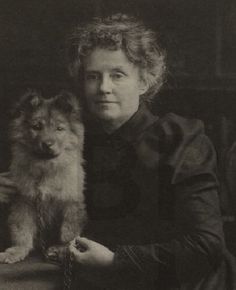
When Whym Chow became gravely ill in 1906, the Michaels went into hysterical overdrive, nursing him around the clock for two days. Eventually, they decided to euthanise him. This act triggered a wave of grief that would sweep them up for several years, and they began work on a book in his honour: Whym Chow: Flame of Love (free to read here).
Quote: “Michael & I love Chow as we have loved no human being” —Katherine Bradley and Edith Cooper (The Michael Fields)
If you weren’t already a bit on edge from the whole niece/aunt thing, then this collection of thirty poems about their beloved (and I mean really beloved) dog will do nothing to make you more comfortable, a heady mix of erotic lesbian imagery and canine idol worship.
Poem: “Love Confessionals There Are”
Pillow, turf, nor sand, nor breast
As confessional I sought:
Nay, but down my face was pressed
In thy wondrous fur, unwrought
Rocked by grief, the Michaels began to sway back towards religion, in the hope it would offer the chance of an afterlife meet up. The Catholic Church, with its flair for drama and repression, was a surprisingly popular choice for queer women at the turn of the 20th century; Katherine and Edith both converted the year after Whym Chow died, and in their grief, their poetry seems to conclude that Whym Chow was essentially Jesus in their own personal holy trinity. Sadly, Musico’s death in 1909 did not generate quite so much of a ruckus.
In 1911, Edith fell ill with cancer, and started the slow process of dying. A new dog, Ferrar the Elk, eased the suffering somewhat, but she succumbed in 1913. Katherine contracted the same disease and died the following year (not before the nun nursing her fell for her). Just before she died, Katherine brought out a limited edition of Whym Chow: Flame of Love as an eternal memorial to their bond.
Katharine Lee Bates and Katharine Coman
Katherine Lee Bates, was a prolific author throughout her life in Massachussets, and famously wrote the lyrics to “America the Beautiful,” a song I never cared to realise existed until I was told a queer woman wrote it.
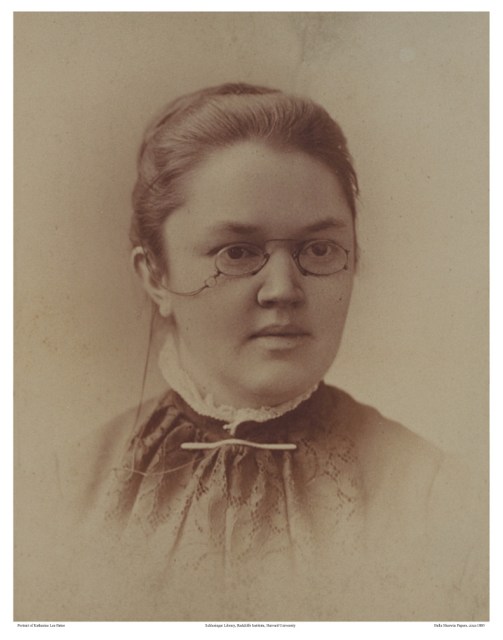
Bates studied at Wellesley College, graduating in 1880, and after teaching at various other institutions, returned to Wellesley in the 1890s to become a professor of English literature and college dean. A crucial part of Wellesley’s magnetism for Bates was the presence of Katherine Coman, her “Joy-of-life”, a history and economics professor at the college. As Bates said: “It was never very possible to leave Wellesley [for good], because so many love-anchors held me there, and it seemed least of all possible when I had just found the long-desired way to your dearest heart.”
The couple formed a Boston Marriage, and in 1907, built a house, “The Scarab,” as a home for themselves and their various pets. Chief among their companions was their beloved collie, Sigurd, whom they had picked up when invited by a neighbour to pick out a puppy from a litter. Sigurd wasn’t on show, as he’d been chained up to be kept as a barn dog because he didn’t fit the pedigree mould. However, Bates and Coman thought him the most beautiful of all the dogs and took him home. The owners said “It’s a queer choice,” which of course in the context of that era means nothing, but in the context of today I would say proves this was an extremely gay situation.
The zest, the fun, the excitement Sigurd infused Into our human humdrum outwent all expectation.
Like any educated queer dog owner worth their salt, Bates dedicated an entire tome to their prized pooch: Sigurd Our Golden Collie and Other Comrades of the Road. The book goes into exhaustive detail about Sigurd’s lineage, puppyhood, first love, and the many adventures of his life.
By day, Sigurd bounded and frolicked through the countryside, with his mistresses in tow. By night, Bates and Coman read to him tales of great literary and historical dogs, although apparently Sigurd preferred poetry and “would softly thump his tail in cadence with the melancholy beat of a dog elegy.”
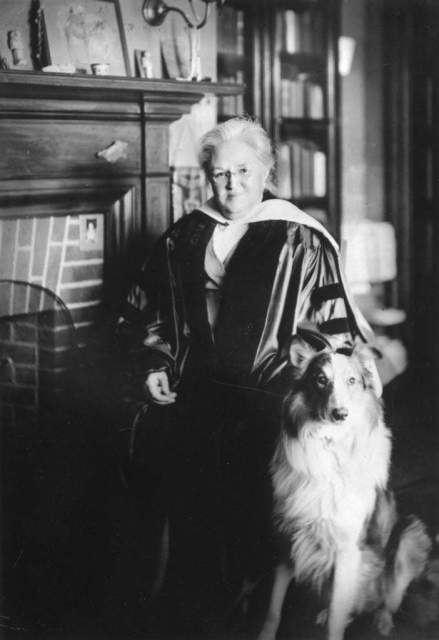
My favourite episode, only alluded to in the book, but described in glorious detail by Albert Peyson Terhune in A Book of Famous Dogs, is when Sigurd makes a foray into am-dram with a part in a college play. After impeccable performances during rehearsals, on they day of the play Sigurd escapes and spends hours rolling around in mud in the woods before being reeled in as the curtain is about to go up. Backstage, he is minimally cleaned up, and when it comes time for him to leap onto stage, he instead slowly crawls onto the set and falls asleep.
“Then across the footlights of the auditorium was wafted a strange and horrid stench that permeated the whole house. Skunk aroma is not dissipated by a single sketchy bath when once it has imbedded itself in the mattress-thick coat of a collie.” Despite receiving rapturous applause, Sigurd did not pursue a further career on stage.
Sigurd died one morning after a lengthy, happy life, during his post-breakfast nap. Despite thinking they’d never be able to replace him, Bates and Coman did eventually get another collie, a melancholy dog they named Hamlet because he always acted like he’d just seen a ghost. Hamlet lived with Bates and Coman until Coman’s death from cancer in 1915. Bates celebrated their life together, publishing Sigurd Our Golden Collie in 1919, and in 1922 a book of her poems to Coman in Yellow Clover, A Book of Remembrance.
Radclyffe Hall
Famed author of notoriously depressing lesbian classic The Well of Loneliness, Radclyffe Hall was born in 1880 and from a young age developed a passion both for writing and for dogs. Throughout a childhood turbulent with the drama of her mother’s three marriages she made a series of canine pals, including her first dog, a pug named Joey, a poodle called Adolfe who got run over, and a terribly seasick Airedale called Yoi.
As a teenager she began to have affairs with women, and was frequently taken for a boy; her name by birth was Margarite, but to all her knew her closely she was John. In 1907, at the age of 27, she met Mabel Batten, a singer 25 years her senior. They began a relationship and moved in together; Mabel recognised Hall’s talent and encouraged her writing, as well as introducing her to a cultured circle of friends. Hall, with a toy fox-terrier called Jill in tow, met Una Troubridge, a cousin of Mabel’s, at a gathering in 1915. The pair were immediately smitten, but didn’t make a move to be together until after Mabel’s death in 1916.

In Una, Hall found a fellow sexual “invert” and dog-lover, though according to Una’s own biography of Hall, it was John that taught her to see animals as more than mere companions, and appreciate their rights as sentient creatures.
Quote: “I am perfectly aware that for people who do not love dogs, there will be too much about them in this story of John’s life; but it is her life I am writing and not theirs, and to her, from childhood onwards, dogs were always an integral part of existence. “
In fact, Hall was so consumed by her devotion to suffering animals that it was virtually impossible for her to go anywhere without encountering some creature that needed rescuing. She travelled frequently in Europe, and though she’d usually take at least a couple of dogs, canaries and even goldfish along, it was the norm that she’d end up finding some strays to take back too.
Some of her rescue dogs included Fido, a big white poodle bought from a street in Florence; Jane, a King Charles spaniel rescued from an area bombed during the Battle of Britain and Rufus, a sable Welsh collie from Battersea Dog’s Home, as well as an unnamed Great Dane weighing five stones (70 pounds) and a tiny Yorkshire terrier who needed its head fur plaited daily. Remember this is on top of their personal pooches, such as:
- an aggressive bull-terrier called Charlie that Hall took driving with her cousin/girlfriend round America
- Olaf, a blue Dane
- Prudence, a tiny Blenheim spaniel
- Raton, a petit brabançon bought in Paris
- Fortune, a French bull bitch
- and Mary Rose, a German black and tan dwarf pinscher who attacked a nun.
Beyond their own pets and rescues, Hall and Troubridge were also keen breeders of Belgian griffons and dachshunds, successfully competing at Crufts and Ladies’ Kennel Club competitions around Britain. Their champion hounds include Thora “The Fairest of Women”, Thorgils, Tinkie, and Wotan, sire of 73 puppies in his first year of breeding. The couple tended to have trouble letting go of their puppies, and would write voluminous instructions to prospective buyers which tended to put them off a bit.
Of the many dogs she shared her life with, Hall’s favourite was a petit brabançon called Tulip, who idolised Hall and had six toes on each paw.

If it wasn’t already crowded enough with the two of them and half the animals in Europe, Una and John took a new entrant into their menagerie: Eugenia Souline. Initially hired by Una to nurse her when she fell ill in Paris in 1934, Eugenie and John struck up a passionate and volatile romance, exchanging many intense letters. Una wasn’t super happy about this situation, but nevertheless the three of them formed a rocky sort of relationship, that would continue until Hall’s death in 1943.
Hall never devoted an entire tome to any of her canine companions, quite probably because it would have been impossible to complete a catalogue of them all. She did make some references to them though — in her first novel The Forge, the dog Sieglinde is a fictional version of Thora, and she wrote a short story never published during her life, about temporarily adopting a stray called Bonaparte on a visit to Corsica.
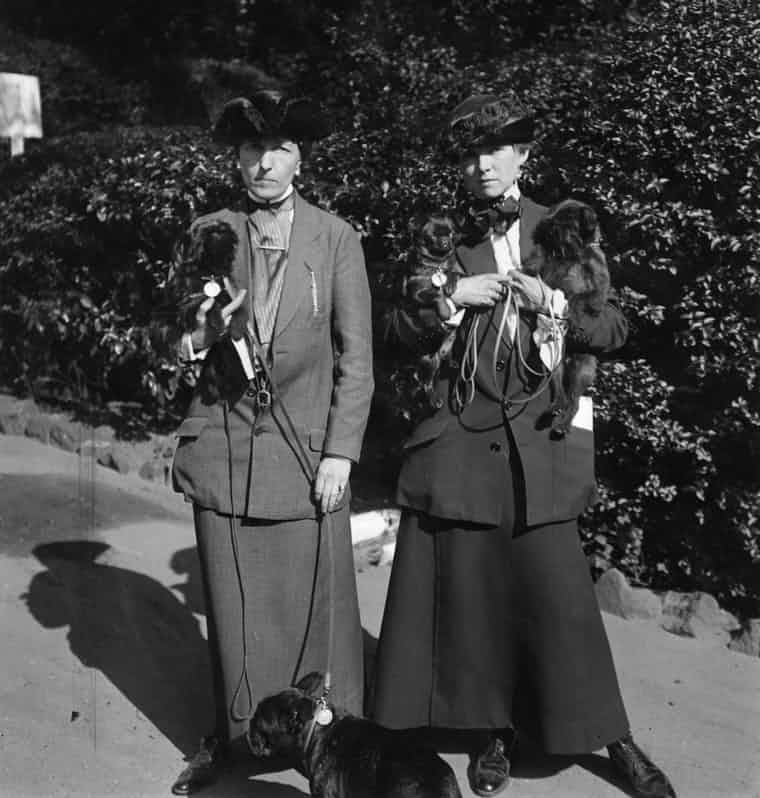
As was inexplicably the fashion among some circles of queer women of the time, Hall was a noted anti-semite and Nazi sympathiser in the 1930s, as well as holding some unfortunately misogynistic views. What a shame it is that she could not extend her all-consuming compassion for animals to the human species.
Colette
Let’s stop and take a breather. At this point, if you’re a dog lover you’re probably thinking “I am a woefully inadequate human being who hasn’t even written a novel about my dog.” If you’re not a dog lover you’re probably thinking: “this goes some way to explain how crazy my ex-girlfriend was.” Well, it’s not going to get any easier, because bisexual French writer and actress Colette takes things to a whole new level.
Ever had a lengthy photoshoot with your dog supermodel in matching owner/doggo clothing? Collete did that first. Do you often imagine what conversations your dog and cat might be having with each other? Well, Colette did that too. Not even dog-related, Colette was quite possibly the first person to publish AU celesbian fanfic — you thought your Krashlyn epics were an innovation? Collette had you beat by 80 years with her re-imagining of the previously mentioned Ladies of Llangollen as left-bank lesbians in Paris.
Sidonie Gabrielle Claudine Colette was born in rural Burgundy in 1873, and aged 16 was whisked off to Paris by Henry Gauthier-Villars or “Willy,” a family friend 24 years her senior and a notorious libertine. Willy encouraged both Colette’s writing and her budding attractions to other women, however, being a man he took both these things for himself. After encouraging Colette to pursue an affair with visiting American heiress Georgie Raoul-Duval, he secretly bedded Georgie himself. Colette’s Claudine series of schoolgirl stories based on her own experiences were published under Willy’s name, and he sold off the copyright, leaving her penniless when their marriage inevitably disintegrated. However, this was not before he arranged a promotional photoshoot for the Claudine books featuring Colette and her little French bulldog, Toby-Chien.
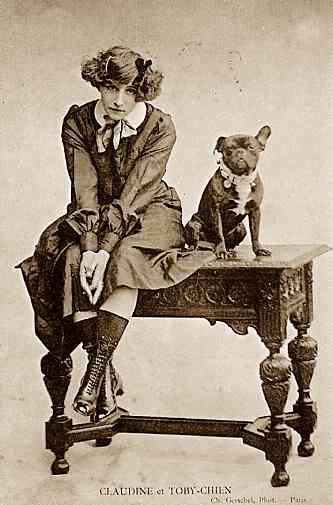
Toby was a constant companion to Colette, and although she shared her life with many subsequent dogs, he was her ultimate canine muse. Both her and Willy were both so attached to Toby that they fought for custody of him when they split, and eventually came to a sharing arrangement.
Colette embarked on a stage career to pay the bills, and in 1907 caused scandal when she and her lover Missy, the Marquise de Morny, performed the first ever girl-on-girl kiss at the Moulin Rouge. I’m kind of surprised the kerfuffle was not about how long it had taken to get a sapphic snog on the stage of Paris’s notably louche nightspot, but audiences were genuinely outraged at the sight of two women kissing, and police threatened to close down the cabaret. Colette had to keep her relationship with Missy on the down-low after this incident, but they did continue to see each other. Colette also had a short affair with Natalie Clifford-Barney because really, who didn’t.
Colette kept on writing, and her first work published under her own name was Dialogues de Bêtes in 1904, which was a series of short scenes of imagined dialogues between her beloved bulldog Toby-Chien and her equally beloved cat Kiki-La-Doucette (Kiki the Demure). Colette frequently features pets in her works, and was said to spend many hours picking fleas from Toby-Chien, her other bulldog Souci, or one of her twelve cats as part of her pre-writing ritual. Obviously this was a highly effective routine, as she went on to author over fifty novels.
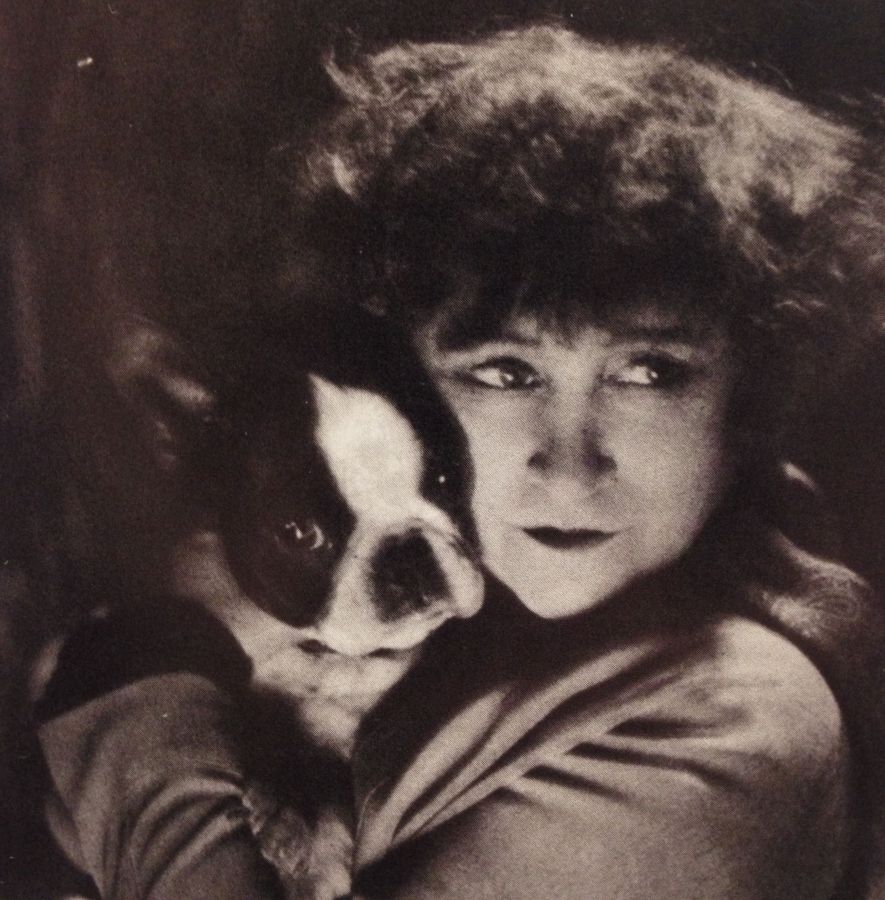
Colette, a film with Keira Knightly in the title role, charting her life with first husband Willy and including scenes of their not-quite-three-way affair with Georgie Raoul-Duval, is out later this year!





